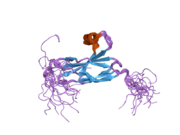Biology:MID2
 Generic protein structure example |
Midline-2 is a protein that in humans is encoded by the MID2 gene.[1][2]
Function
The protein encoded by this gene is a member of the tripartite motif (TRIM) family. The TRIM motif includes three zinc-binding domains, a RING, a B-box type 1 and a B-box type 2, and a coiled-coil region. The protein localizes to microtubular structures in the cytoplasm. Its function has not been identified. Alternate splicing of this gene results in two transcript variants encoding different isoforms.[2]
Recent reports indicate the involvement of MID2 in cytokinesis [3][4].MID2 (TRIM1) ubiquitinates Sperm-associated antigen 5 (Astrin) on K409, further promoting its degradation and proper cytokinesis.[4] In contrary, depletion of MID2 (TRIM1) stabilizes Sperm-associated antigen 5 (Astrin) whose inappropriate accumulation at the midbody triggers cytokinetic arrest, multinucleated cells, and cell death.[3][4]
Interactions
MID2 has been shown to interact with MID1.[5][6]
MID2 (TRIM1) interacts with Leucine-rich repeat kinase 2 (LRRK2), which is often subject to missense mutations in familial Parkinson's disease (PD).[7] MID2 (TRIM1) specifically binds to the flexible regulatory loop of LRRK2853–981.[7] MID2 (TRIM1) recruits LRRK2 to the microtubule cytoskeleton where MID2 (TRIM1) ubiquitinates LRRK2 targeting it for proteasomal degradation.[7]
References
- ↑ "MID2, a homologue of the Opitz syndrome gene MID1: similarities in subcellular localization and differences in expression during development". Human Molecular Genetics 8 (8): 1397–1407. August 1999. doi:10.1093/hmg/8.8.1397. PMID 10400986.
- ↑ 2.0 2.1 "Entrez Gene: MID2 midline 2". https://www.ncbi.nlm.nih.gov/sites/entrez?Db=gene&Cmd=ShowDetailView&TermToSearch=11043.
- ↑ 3.0 3.1 "Emerging Roles of the TRIM E3 Ubiquitin Ligases MID1 and MID2 in Cytokinesis". Frontiers in Physiology 10: 274. 2019-03-19. doi:10.3389/fphys.2019.00274. PMID 30941058.
- ↑ 4.0 4.1 4.2 "The X-Linked-Intellectual-Disability-Associated Ubiquitin Ligase Mid2 Interacts with Astrin and Regulates Astrin Levels to Promote Cell Division". Cell Reports 14 (2): 180–188. January 2016. doi:10.1016/j.celrep.2015.12.035. PMID 26748699.
- ↑ "The tripartite motif family identifies cell compartments". The EMBO Journal 20 (9): 2140–2151. May 2001. doi:10.1093/emboj/20.9.2140. PMID 11331580.
- ↑ "MID1 and MID2 homo- and heterodimerise to tether the rapamycin-sensitive PP2A regulatory subunit, alpha 4, to microtubules: implications for the clinical variability of X-linked Opitz GBBB syndrome and other developmental disorders". BMC Cell Biology 3: 1. 2002. doi:10.1186/1471-2121-3-1. PMID 11806752.
- ↑ 7.0 7.1 7.2 "The E3 ligase TRIM1 ubiquitinates LRRK2 and controls its localization, degradation, and toxicity". The Journal of Cell Biology 221 (4): e202010065. April 2022. doi:10.1083/jcb.202010065. PMID 35266954.
Further reading
- "A protein-protein interaction network for human inherited ataxias and disorders of Purkinje cell degeneration". Cell 125 (4): 801–814. May 2006. doi:10.1016/j.cell.2006.03.032. PMID 16713569.
- "An Xq22.3 duplication detected by comparative genomic hybridization microarray (Array-CGH) defines a new locus (FGS5) for FG syndrome". American Journal of Medical Genetics. Part A 139 (3): 221–226. December 2005. doi:10.1002/ajmg.a.30991. PMID 16283679. https://lirias.kuleuven.be/handle/123456789/40078.
- "Towards a proteome-scale map of the human protein-protein interaction network". Nature 437 (7062): 1173–1178. October 2005. doi:10.1038/nature04209. PMID 16189514. Bibcode: 2005Natur.437.1173R.
- "Trim5alpha protein restricts both HIV-1 and murine leukemia virus". Proceedings of the National Academy of Sciences of the United States of America 101 (29): 10786–10791. July 2004. doi:10.1073/pnas.0402876101. PMID 15249690. Bibcode: 2004PNAS..10110786Y.
- "MID1 and MID2 homo- and heterodimerise to tether the rapamycin-sensitive PP2A regulatory subunit, alpha 4, to microtubules: implications for the clinical variability of X-linked Opitz GBBB syndrome and other developmental disorders". BMC Cell Biology 3: 1. 2002. doi:10.1186/1471-2121-3-1. PMID 11806752.
- "The tripartite motif family identifies cell compartments". The EMBO Journal 20 (9): 2140–2151. May 2001. doi:10.1093/emboj/20.9.2140. PMID 11331580.
- "FXY2/MID2, a gene related to the X-linked Opitz syndrome gene FXY/MID1, maps to Xq22 and encodes a FNIII domain-containing protein that associates with microtubules". Genomics 62 (3): 385–394. December 1999. doi:10.1006/geno.1999.6043. PMID 10644436.
- "Functional characterization of the Opitz syndrome gene product (midin): evidence for homodimerization and association with microtubules throughout the cell cycle". Human Molecular Genetics 8 (8): 1387–1396. August 1999. doi:10.1093/hmg/8.8.1387. PMID 10400985.


